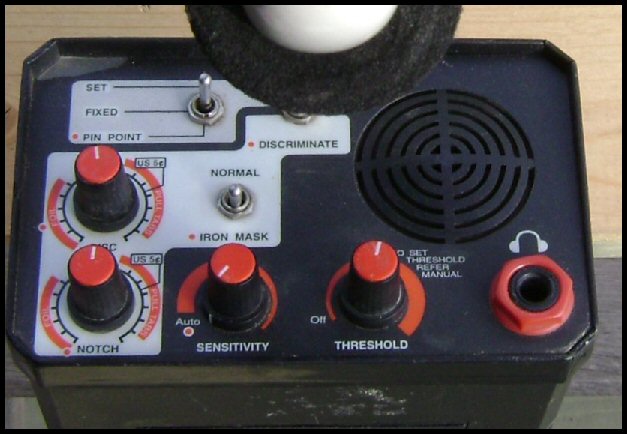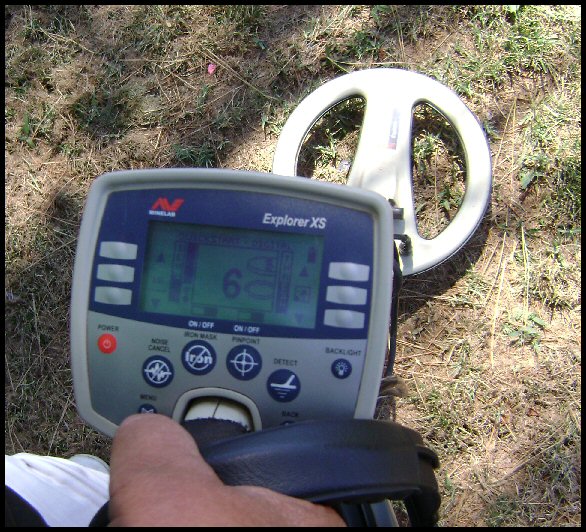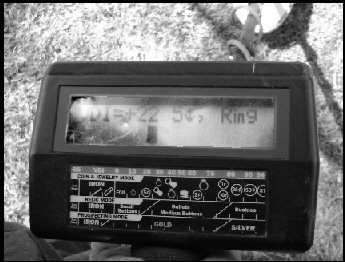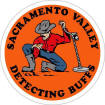Crucial Concepts in Metal Detecting
(Reprinted from “Metal Detecting for the Beginner” with permission from the author.)1. Discrimination and notch filtering
Discrimination is the ability of the detector to distinguish between one target and another. In most cases this translates into being able to distinguish between a coin and trash, such as between a quarter and a bottle cap. The composition of the object being scanned has an effect on the signal received by the metal detector. This effect is called phase shift. A positive, or leading, phase shift indicates a highly conductive target, such as a silver dime. A negative, or lagging, phase shift generally indicates junk, such as a rusty nail. An adjustable discrimination dial lets the operator tune out and reject signals from the junk targets.
The discriminator dial, in effect, blocks any response from the detector for targets with a phase shift at or below the level you select. Unfortunately, when you tune out the pull-tabs from soda cans you also tune out nickels and some jewelry. Experience adjusting the discriminator setting then becomes an important part of the learning curve for the novice coin-shooter. Some advanced metal detectors (more expensive) let you tune out only certain portions of the phase shift spectrum. This is called “notch filtering.” For example, you could tune out most of the pull tabs and still get nickels with careful notch filtering.
As you might guess, discrimination is extremely valuable in the field, where you don’t want to spend a lot of time digging up garbage. In some situations, such as relic hunting, discrimination might not be as crucial, since relic hunters will often choose to dig up everything made of metal.

Detector controls with Discrimination and NOTCH filtering dials shown at left. This detector uses sounds for target identification.
2. Target identification (TID)
Target Identification is closely related to discrimination. Modern discriminating metal detectors can tell you if the target is a copper penny (minted before 1982) or a zinc penny. It can tell between a silver dime (minted before 1965), and what we call a “clad” dime, one that is a composite of copper and nickel.
The output of the discrimination circuitry can be an audible tone, with a high pitched tone for valuables and a low grunt for junk. This is called tone identification. The output is more commonly a meter reading, or a numeric value called a VDI number which appears on a screen. VDI stands for Visual Discrimination Indicator. Discrimination output sometimes uses multiple modes to alert the operator. A high-pitched tone will indicate a high-conductivity target, while the LDC display shows both a VDI number and a probable target. On White’s metal detector, for example, a nickel might appear as “VDI = 18 Nickel” on the display, or “VDI = 80 Dime, Penny.”
Target Identification is not always accurate. The error rate tends to go up when the target is deeper in the ground.

This type of detector uses a display to show target identification using VDI numbers.
3. Sensitivity
Sensitivity refers to the ability to detect metal objects from a distance. It is something akin to the volume control knob on an amplifier. Set too low, you won’t hear the music. Set too high and you get distortion and chatter. Most detectors with sensitivity control have a mark on the control panel where the manufacturer recommends you set the dial. Under certain conditions, such as areas of high mineral content, or near power lines, it may be necessary to lower the sensitivity to cut down on noises and false signals.
4. Search depth
The depth that your machine is able to search for coins depends on a number of factors. These include:
• Detector operating frequency. The lower frequencies have better depth.
• The strength of the magnetic field created by the detector; the stronger the field, the deeper thepenetration.
• The size and shape of the search coil. Generally the larger the coil, the deeper it can search. Some coils employ two separate D-shaped windings. These “DD” coils distort the shape of the magnetic field and enable deeper searching.
• The composition of the ground being searched and its electrical characteristics. This is usually referred to simply as “mineralization”, but it may include such variables as how tightly the ground is compacted, the presence of water, and the chemical makeup of the soil.
• The shape, size, and orientation of the object. A dime buried on its edge, for example, would be more difficult to detect than one laying flat (parallel to the surface).
How Deep Will This Coil Go??
The truth is, nobody can really say with certainty, due to the variables mentioned above. To be on the safe side, consider the half and half idea: You can easily find coins down to a depth of half your coil diameter. If you’re using an 8-inch circular coil, you’ll easily find coins at 4 inches. The other half is tricky. Under ideal circumstances – good ground conditions, finely tuned detector, experienced operator, a flat-lying silver coin, and fresh batteries – you might make up the other half, so you could get down to a full 8 inches. It’s in this borderland region, between half the coil diameter and the full diameter, where Target Identification suffers, the signal becomes weak or intermittent, and your skill and patience at detecting pays off. This of course is just a general observation. There are experts in this hobby who will swear they can find coins much deeper than 8 inches using and 8-inch coil.
5. Ground balance
All soils contain some degree of metals, such as iron, which can interfere with a detector’s ability to find coins. Ground balancing allows the detector to see past these minerals. There are different ways to set ground balance:
• Factory preset ground balance. Here the manufacturer sets the ground balance at a predetermined level, which they estimate will work adequately in most searching environments. This “fixed” ground balance may be a less desirable compromise, but it lowers costs and works well in normal soil conditions.
• Automatic ground balance. Many modern detectors now employ circuitry which detects and adjusts forground effects automatically.
• Manual ground balance. Manual ground balance requires the user to adjust for ground balance at the start of each searching session. This is a simple procedure where the user adjusts a setting on the detector with the coil alternately up in the air, then near the ground. Some detectorists prefer manual ground balance, at least as an option, since it provides greater control in prospecting, where changes in ground conditions are important for assessing the presence of gold-bearing ore.
• Mixed or combined methods of ground balance. Manufacturers often allow owners to select manual or automatic ground balancing, simply by flipping a toggle switch on the detector. As mentioned above, in some circumstances, such as prospecting for gold, the owner may want more control over settings on the detector. Think of it as automatic transmission versus a manual clutch.
6. Detector operating frequency
Detectors use very low frequency sine wave oscillations in the coil to detect their targets. The vast majority of detectors on the market today use an operating frequency between 3,000 and 20,000 cycles per second, or hertz. The typical land-oriented detector might use an oscillator at 7,000 cycles per second, abbreviated 7k Hz.
For purposes of selecting a detector, the crucial point to remember is:
• The higher the frequency, the easier it is to detect small objects, such as BB-sized relics or minute specsof gold. Higher frequencies, however, are less able to penetrate deep into the ground.
• The lower the frequency, the deeper your detector can scan, with the same sized coil. Lower frequencies, however, are less efficient at picking up very small objects.
Detector operating frequency is not like a computer clock speed, where the faster it goes the better. The different frequencies are more suited for specific purposes. For high frequencies, imagine shooting sewing needles into the sand. They are good for picking up tiny objects, but they don’t go very deep beneath the surface. Next shoot hundreds of nails into the sand. They go deeper than the needles, and are good for detecting coin-sized objects. Finally, shoot a few large tent stakes into the sand. They penetrate much deeper, but are not good at finding tiny objects. They are suited for finding larger objects
Some manufacturers now produce detectors which generate multiple simultaneous frequencies for the same coil. This type of detector will span a much greater spectrum of both depth and object size. The Minelab Safari metal detector, for example, boasts 28 frequencies. Although this improves your detecting options, it also adds to the cost of the detector.

Target ID using VDI numbers. Here a +22 indicates a nickel or a ring.
Sacramento Valley Detecting Buffs- © Copyright 2010

